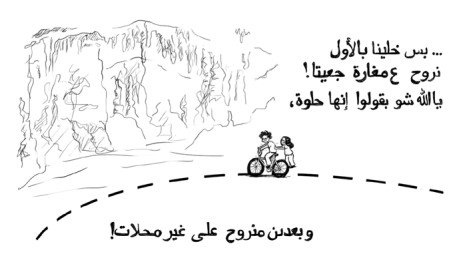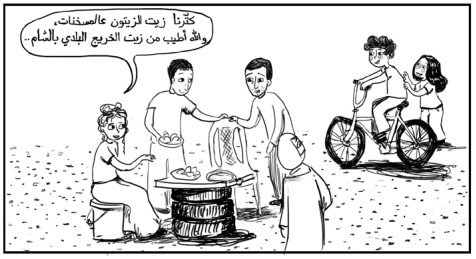Nostalgia and solastalgia in Lebanon’s refugee and host communities
by Dr Helen Adams
22 Jun 2018
Place is part of our identity. Emotional attachments to place contribute to our well-being and feelings of identity – if we understood the places from which refugees gain solace, we might be able to build on the positive benefits. But attachments don’t just exist to the physical place in which we live. For example, we can feel an attachment, or nostalgia, for places that we used to live in, or that we heard our grandparents talk about, or iconic places that we might like to visit one day.
When the places we call home are threatened, we can take it very personally and act against those threats. Therefore it’s important to understand how local host communities feel about where they live, and how their places have been affected by refugees arriving, especially if we want to build social cohesion. The concept of “solastalgia”, coined by an academic called Albrecht, describes the distress experienced by people when their homes change around them. This has usually been applied to environmental change, such as mining projects, but here I apply it in the context of population change.
The project
I lead on a project researching refugees and their host communities in Lebanon, through the perspective of emotional bonds to place. Even though being forced to leave home is common to all refugees, we rarely try to understand their lives from this perspective – of home, homelessness and homesickness. I wanted to understand how and where refugees thought of home, and whether the changes brought by refugees had affected host communities’ attachment to place. Some rural villages in Lebanon have experienced a four-fold increase in size since the conflict began.
We interviewed Syrian refugees and Lebanese locals. We also focused on the Palestinians in both these populations who have a very different experience of home and displacement; 34,000 Palestinian Syrian refugees have arrived in Lebanon joining the 280,000 Palestinians already there. We asked questions on everyday life; significant people, places and objects; ideas of home; memories; and changes to places over time.

Excerpt from ‘A narrow path can fit a thousand bicycles’, a graphic novel based on the project’s research
Why Lebanon?
Most of the refugees who have fled the conflict in Syria are in the neighbouring countries of Lebanon and Jordan. Lebanon is a small country with a population of four million, which now has 1.5 million refugees registered with the UN refugee agency, with no doubt many more unregistered. Lebanon is itself a recipient of aid, politically fragile since its civil war ended, and has a complex and tense history with Syria. The Lebanese government, like many countries that find themselves with refugees, would prefer the stay of the Syrian refugees to be temporary, and thus it is making it increasingly difficult for Syrians to continue to reside in Lebanon. Refugees in Lebanon exist in a situation of extreme poverty and precarity; but often the situation for the locals is not much better. For this reason, I started working in Lebanon.
Nostalgia for Syria
We found that the refugees still have strong connections to Syria. These connections are maintained through communication with people still living in, or who have visited Syria, and through sharing memories with other Syrian people in Lebanon. While these memories provide an escape from the drudgery of everyday life and provide a way for diverse refugee communities to come together, the associations become increasingly symbolic, as the Syria remembered no longer exists.
Syrian respondents showed diverse relationships to their current place of residence. While some experienced their homes as oppressive spaces, others found peace of mind in the places they had created. Sometimes, the act of building and customising homes provides a site of agency and control that is severely lacking in other parts of their life.
Solastalgia for village life
The Lebanese locals were firmly rooted in place, keenly aware that their village was part of their identity. The increase in population has meant the loss of a tight-knit community; this was sometimes expressed by locals as a feeling of insecurity. There is also a perception that Syrians have increased economic hardship by creating competition for jobs and in business.
Yet not all locals see the changes happening as negative. Respondents enjoyed going to the new market, appreciated the benefits and services available in the larger settlement, and admired the newcomers for their tenacity and hard work. Some respondents perceived the beginnings of cultural exchange between locals and the refugees; small changes in behaviours and practices that have resulted from continued co-existence.

Excerpt from ‘A narrow path can fit a thousand bicycles’, a graphic novel based on the project’s research
Finding common ground
Both refugees and their host communities have had emotional bonds to place broken: refugees through their forced migration, and locals with the arrival of the refugees, among other factors. Both, in a sense, have been displaced, and thus solutions to increasing the well-being of both populations lie in the purposeful building of new and common emotional bonds to the transformed location.
We expand on these ideas in a downloadable project report, that can be downloaded here. Studio 27 in Beirut have also produced a short illustrated novel, A narrow path can fit a thousand bicycles, based on the findings of the research – currently only in Arabic (with translation) but soon to be out in English as well. We made the illustrated novel so that respondents could get a sense of the research, without having to read the report. Finally, we have transcribed and translated 20 of our interviews into English – these will be available to download from the UK Data Archive’s ReShare repository soon using the search term: “Precarious Places: Social cohesion, resilience and place attachment in refugee-host interactions”.
This month I am going back to Lebanon to visit the people we interviewed, give them copies of the report and illustrated novel and see if they have any feedback on the interview process itself – whether there were any positive or negative implications from having spoken to us.
Dr Helen Adams, King’s College London, is the Principal Investigator of Precarious Places: Social cohesion, resilience and place attachment of refugees in Lebanon. This project is funded under the British Academy's Humanities and Social Sciences Tackling the UK's International Challenges programme which, along with the Knowledge Frontiers programme, aims to deliver excellent research with relevance to public and policy debates. A new application for both programmes will be opening soon.


